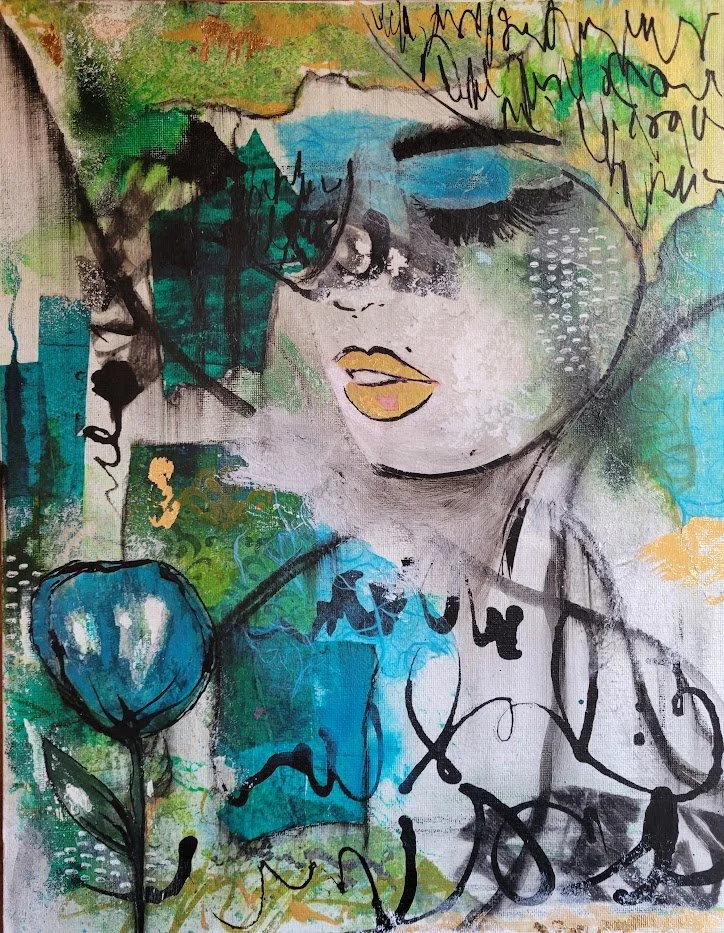
Rule #1:
Learn the rules so you can break them.
How I work…
My process is a balance (mostly) of intuition with intention. I prefer to work on multiple pieces at one time and explore all the possibilities I can within certain boundaries and parameters I’ve set for myself.
I like to develop a series or collection based around a concept. The concept is a combination of the original intention or story I wish to tell plus the act of painting itself.
I make a conscious effort in my day-to-day life to search, wonder, explore, and stay curious so that when I show up in the studio, I feel open and free to create authentically.
Everything I see and do, from the mundane to the more complicated bits in life, is all potential inspiration that often shows up in my pieces.
Mixed media, to me, is like speaking multiple languages.
You have to understand each of the mediums individually, what works well with what, what goes on top of what, what order you need to work in, so you can then translate them into one language, one cohesive piece.
A commissioned triptych in progress.
My intention can begin with a feeling, a story or quote, a single color, or even a long walk for inspiration. It can also begin just by showing up every day in my life and my studio and observing and being present.
I start by activating the canvas with marks—random, loose, and expressive. I drop pops of color on top of the marks with either watercolor, acrylic or India ink. I am looking for balance, harmony, and movement that give me somewhere to go.
The layering process is fascinating and freeing, to be sure. Every layer is my favorite layer, from the first marks and playing with color, to contrasting transparent glazes with textured thick paint, the splatters, sanding and scratching back to reveal hidden treasures underneath, and all the final details.
Discovering this approach to art and developing my own process has been the key to unlocking my creative energy.
I work on paper, stretched canvas, and canvas panels, but I love cradled wood panels the most. They take anything and everything that I throw at them and more. The process is a considered one, but not always tidy and gentle.
“I begin with an idea and then it becomes something else.”
My style is ever evolving, as am I, but ‘lyrical abstraction’, a way of expressing something personal, subjective, and emotive in a poetic, provocative, semi-abstract way, is an accurate description of how I work and why I make art in the first place.
The distinction between abstraction and representation is less interesting to me than knowing my work expresses authentically who I am.
Loose (but bold) renditions of women are something I’m working on as I feel they highlight the beauty of bodies at any age as well as capture the universal energy within.
I am also moving toward my own style of “disrupted realism”, in which I am trying to challenge and reshape the tradition of realistic, representational art.
Late night art journaling session.
Female faces, shapes, and figures are a foundational inspiration for me.
I want to capture feminine strength, sensuality, vulnerability, intuition, innovation, creativity, and resilience.
Watercolor Portrait Study, 2023
Watercolor and graphite study, 2021
“Meet Me Where the Wild Things Grow”
Mixed Media on Aquabord, 2021
I aspire to create:
hand painted paper packs for artists
handmade books and journals
3D art
murals
street art
product and surface design
THINGS I LOVE THAT OFTEN FIND THEIR WAY INTO MY WORK:
Flowing lines and expressive marks
Layered backgrounds
Shapely feminine figures, faces, and silhouettes
Thought provoking and empowering words, phrases, quotes
Script font, asemic writing, poetry
Abstract and semi-abstract symbols of nature: sun, moon, trees, flowers, botanicals, dragonflies and insects, wind, sky, clouds, water, mountains
Surreal imagery
Vintage imagery and old photos
Gold and other metallics
Bright, bold color combinations
Black and white with a pop of one or two colors
Limited palette of only 2-3 complimentary colors
Sgraffito: scratching into layers of paint to write or create texture
Circles as symbolism (mandalas, labyrinths)
Embroidery and stitch patterns—drawn marks as well as actual sewing by hand and/or machine
Texture with paper, cloth, and fabric











